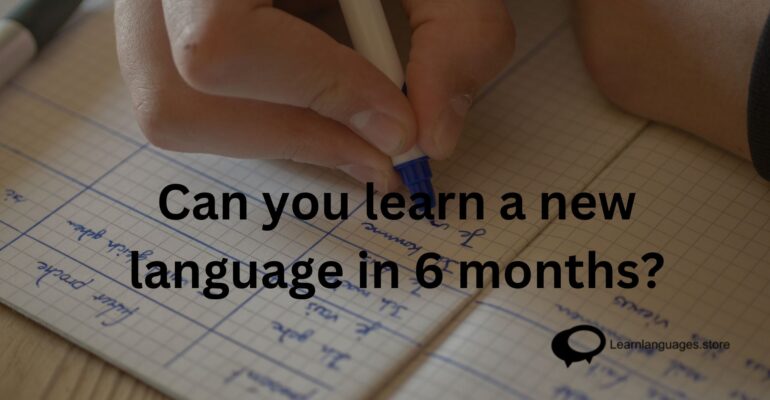Can you learn a new language in 6 months?
Can you learn a new language in 6 months?
Estimated reading time: 6 minutes
Can you learn a new language in 6 months? – The perfect system for learning any language quickly, Most people have “learn a second language (or maybe a third or a fourth)” at the top of their bucket lists. However, how do you learn a new language quickly and effectively as an adult?
Chris Lonsdale is a psychologist from New Zealand who runs a company in Hong Kong. He’s been interested in accelerated learning his whole life. After spending many years assessing all of the research available on language learning, he was able to formulate five principles and seven actions that will allow any normal adult to learn a new language and speak it fluently in six months.
Table of contents
I discovered Lonsdale’s approach when I came across his TED Talk. Below you’ll discover Lonsdale’s five principles and seven action steps for learning a new language in just six months.
The Five Principles
Lonsdale’s five principles of rapid language acquisition are the following:
1. Focus on language content that is relevant to you. Why do you want to learn to speak a second language? Look at the following:
- Do you want to learn Italian so that you can understand opera? If so, then concentrate on words and phrases that you would hear in Puccini’s operas.
- Do you want to learn to speak Mandarin so that you can communicate with your business partners in China? Then focus on learning words and phrases in Mandarin that are related to business.
2. Use the new language as a tool to communicate. Instead of simply learning the language in an academic setting, put yourself in situations that force you to use the language in order to be able to communicate with others.
3. When you first understand the message, you will unconsciously acquire the language. When you’re first trying to learn a new language, instead of trying to understand the words that someone is using to talk to you, try to understand what they’re trying to say through their gestures, body language, and facial expressions.
That is, at first you don’t derive meaning from the language, but from the interaction. This is something called comprehension input, and it’s been well documented.
4. Learning a language is not about acquiring knowledge. Instead, in many ways, it’s about physiological training.
First of all, we have filters in our brains that filter in sounds that we’re familiar with, and that filter out sounds that we’re not familiar with. And if you can’t hear it, you can’t learn it. Therefore, you have to continually listen to the sounds of the language that you’re trying to learn in order to train your brain to let in the new sounds.
In addition, talking requires using your facial muscles. You have 43 muscles in your face. You have to coordinate those muscles in a way that makes sounds that others can understand
5. Your psychological state matters. If you’re sad, angry, worried, or upset, you’re not going to learn the new language. If you’re happy, relaxed, and curious, you’re going to learn the new language quickly. In addition, you need to be tolerant of ambiguity. At first, when people speak to you in the language that you’re trying to learn, you’ll understand very little. But that’s OK.

The Seven Actions
Based on the five principles that were explained above, there are seven actions that you need to take in order to learn a new language quickly and efficiently. The seven actions that Lonsdale recommends are the following:
1. Listen; a lot. Lonsdale calls this brain soaking. It doesn’t matter if at first, you don’t understand what you’re listening to. You’re listening to recognize patterns, words that repeat, and things that stand out. In addition, you’re listening to the rhythm of the language.
2. Focus on getting the meaning first, even before you get the words. From body language, you can understand a lot of communication. You’ll be acquiring the language through comprehension input.
3. Start mixing. If you know ten verbs, ten nouns, and ten adjectives in the new language, you can say 1000 different things. Language is a creative process. Look for ways to get your meaning across by using the words that you know.
4. Focus on the core. With every language, there’s high-frequency content. As an illustration, in English, one thousand words cover 85% of anything you’re going to say in daily life. Three-thousand words give you 98% coverage. All the other words in the English language are the icing on the cake.
5. Get a language parent. When you start learning a language your progress will probably look like the following:
- Week 1: Continually ask “What is this?”, “How do you say . . .”, “Can you say that again?”, “Can you repeat that?” Always ask these questions in the language that you’re trying to learn.
- Week 2 and 3: You should be using very simple nouns, verbs, and pronouns (“you”, “me”, “that”, “hot”, “give”, and so on).
- Week 4: You’re using glue words, such as “and”, “but”, “even though”, “therefore”, and so on. These words tie bits of language together so that you can make more complex meanings. At this point, you’re talking in the new language.
This is where you want to get a language parent. That is, someone who will treat you like a parent treats their child when the child is learning to speak. In this language, parents can recognize what you’re saying, even when others don’t understand. They create a safe environment for you, which makes you more confident in your ability to learn the new language.
The four rules for a language parent are the following:
- They will work hard to understand what you’re trying to say.
- They don’t correct your mistakes.
- They confirm understanding by using the correct language.
- They use words that you know and also communicate with gestures and body language.
6. Copy the face. In order to learn to make the sounds that will allow you to speak the new language, you have to watch the face of people who speak that language. How does their face move when they’re speaking? Mimic their facial movements.
7. “Direct Connect” to mental images. Most people learning to speak another language will make a list of words that they want to learn in their mother tongue, and next to each word they’ll place the equivalent in the language that they’re trying to learn. Then they just go over the list repeatedly in the hopes of memorizing the words in the new language. This is very inefficient.
Everything that you know is an image inside your mind. For example, if you talk about fire you can smell the smoke, feel the heat, hear the crackling, and see the flames. What you want to do is to focus on the image that’s currently in your head for “fire” and create a new pathway that leads from this image to the word “fire” in the language that you’re trying to learn.

Ready to learn one of the easiest languages?
Don’t stop here…continue learning and start by choosing an easy language from the 14languages that Learnlanguages.store offers.
We think you might also like…
- Which Language Should I Learn Abroad in India?
- Is It Possible to Learn a Language Using Podcasts?
- Learn Faster? Design At Home Program
- 8 Myths: Of Your Language Learning
- Cognitive Language Learning Perspectives
- Is Social Media Effective in Language Learning?
Learn Languages Store
Vashi,
Email: services@learnlanguages.store










